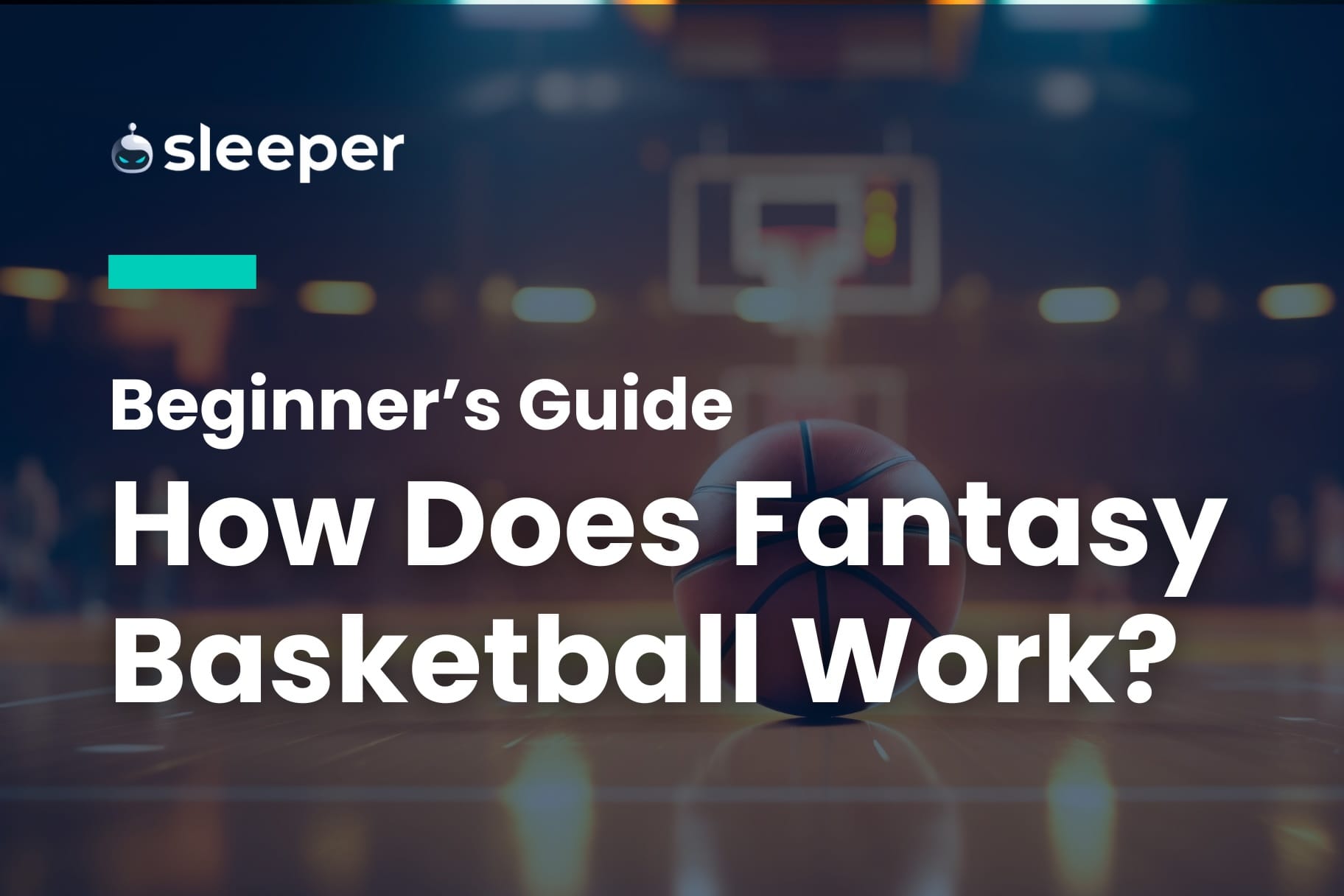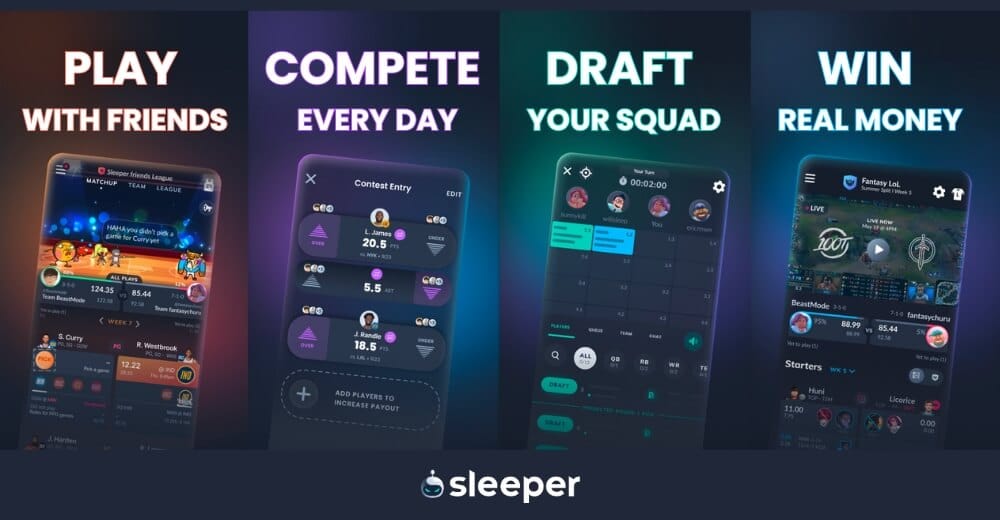Have you always wanted to try fantasy basketball, but you aren’t sure where to start? This is your ultimate guide to all things fantasy hoops.

In recent years, fantasy basketball has become more and more popular. Once NBA fans and DFS players try a season-long league, they tend to fall in love.
If you're curious about experiencing the thrill of fantasy basketball for the first time, or you just want a refresher on the basics, this guide is for you. We’ll cover everything you need to know to get started, including how it works, various types of leagues, different scoring systems, tips for your draft, and much more.
What Is Fantasy Basketball and How Does It Work?
Modern fantasy sports started appearing in 1980 when a group of journalists formed the first fantasy baseball league called “Rotisserie League Baseball” – named after the restaurant where they would meet, La Rotisserie Française. These journalists invented the scoring system, drafted teams of MLB players, and tracked the stats manually.
Over the next couple decades, fantasy sports took off in popularity, especially once the internet made it significantly easier to play amongst friends. Naturally, fantasy hoops followed.
Like all fantasy sports, fantasy basketball involves drafting individual NBA players to your fantasy roster, where each player earns points based on their real life statistical output. The goal is to build the best roster and outscore the other teams in your league.
The league holds a draft (either online or in-person) where everyone selects their players. Then, throughout the season, each individual manages their roster – setting their lineup, making trades, and adding players via the waiver wire.
Types of Fantasy Basketball Leagues

There are three types of fantasy basketball leagues, and they each have their own pros and cons. Let’s break down the various league format options.
1. Redraft
At the start of the season, managers draft a team and all players are available. Then, the rosters reset at the end of the season.
2. Keeper
Each manager can designate a certain number of players to keep on their roster for next season. The number of keepers is customizable.
3. Dynasty
In a dynasty league, each manager drafts a team and keeps all the players for the entirety of their career (unless they’re traded or dropped). The only additions each year are waiver-wire players (i.e. free agents) and incoming NBA rookies (via an annual rookie draft).
DFS (Daily Fantasy Sports)
Beyond traditional season-long fantasy leagues, a format growing in popularity is DFS, which allows you to pick players in a daily or weekly format. Platforms such as Sleeper Picks give you a chance to get back in action on a daily basis by selecting two or more players at a time and then picking whether they will have more or less than their projected stats for that day.
DFS involves a different type of strategy than season-long fantasy basketball leagues, but requires a similar level of analysis of players, matchups and NBA schedules. To learn more about getting into this exciting fantasy format, check out our guide on playing DFS.
How To Choose a Scoring Format
There are several options when it comes to fantasy basketball scoring.
First, your league must decide if you want to play in a points league or nine-category league.
Points League
Every stat is worth a specific amount of fantasy points. Throughout the week, players rack up fantasy points as they play in their NBA games. The goal is for your roster to outscore the other teams in the league. Here’s a common points system: Points = 1, Rebounds = 1.2, Assists = 1.5, Steals = 3, Blocks = 3, Turnovers = -1
Nine-Category League
In a nine-category league, the goal is to win more statistical categories than your opponent. The nine categories are points, rebounds, assists, steals, blocks, threes, field goal percentage, free throw percentage, and turnovers. You must build a balanced roster with a wide array of skill sets, so your team is well-rounded and fares well in multiple categories.
Then, your league must decide whether you want to have head-to-head matchups or rotisserie scoring.
Head-to-Head Matchups
Managers square off head-to-head each week to see whose team can score the most points or win the most categories. At the end of the season, several teams make the playoffs and go head-to-head in a postseason bracket. A head-to-head championship matchup determines the winner.
Rotisserie Scoring
Rather than facing one manager each week, teams are ranked at the end of each week based on their roster’s combined points or number of categories won. At the end of the year, whoever is No. 1 in the standings is the winner. There’s no postseason.
You can further customize your league’s scoring on Sleeper, with “Game Pick Mode” or “Lock-in Mode.”
Lock-in Mode
Each week, you choose one performance to lock in for each of your players. If you want to lock in a performance, you must do so before the player’s next game starts. A player must be in your starting lineup in order to be lock-in eligible.
Game Pick Mode
Each week, you select one game per player that counts toward your matchup. You choose the game before it starts. Once a selected game begins, the player is locked in place until your matchup ends. (If your player doesn’t play for some reason, a new game can be selected).
Drafting Your Fantasy Basketball Team

Fantasy basketball drafts are typically 12 or 13 rounds. Managers are trying to fill out their roster, which typically consists of the following positions:
- PG
- SG
- G
- SF
- PF
- F
- C
- C
- UTIL
- UTIL
- BN (bench)
- BN (bench)
- BN (bench)
- IL
While most of the positions are self-explanatory, the UTIL (utility) spots are essentially wildcard spots where you can start any player. The IL (injured list) spot allows managers to stash an extra player who is hurt without taking up a roster spot.
Most leagues will hold a snake draft, which is where the draft order reverses each round. For example, in a 10-team league, the manager picking 10th in the first round would get the first pick in the second round. This is meant to even the playing field, so certain draft slots aren’t drastically better than the others. (However, drafting early and landing one of the top players in the league does present an advantage).
Tips for First-time Drafters
Prior to the draft, find a list of player rankings (or build your own) and use them to evaluate players. Every platform ranks players differently, so by following these rankings, you’ll have an expert opinion on hand and you can identify values when certain players fall lower than expected in the draft.
While building your team, it’s important to pay attention to position scarcity. Centers tend to be valuable in fantasy basketball, so they get drafted early and the position dries up quicker than others (similar to running backs in fantasy football).
If you’re playing in a dynasty league, your start-up draft will have more rounds, as the rosters (and sometimes starting lineups) tend to be larger.
Also, in a dynasty league or keeper league, younger players will have more value since you’re drafting players for the long haul. Prior to the draft (or early in the draft), determine your team’s championship window. Some managers target win-now pieces in hopes of contending immediately, while others build for the future by prioritizing young players. Some try to find a perfect mix of youth and veterans. Determining what kind of roster you want to build will help you identify which players to target when you’re on the clock in your draft.
Pro Tip: Use the Sleeper app for research and analysis. Sleeper's in-app tools offer the latest news updates, advanced statistics, roster and start percentages, injury reports and much more.
Fantasy Basketball Waiver Wire
After the draft, you’ll have plenty of opportunities to improve your roster throughout the season. The easiest way to add reinforcements is via the waiver wire – the free-agent pool of available players who didn’t get drafted.
Managers can add and drop players from the waiver wire, although some leagues have a maximum number of waiver-wire additions a manager can make each week.
Paying attention to the waiver wire is important, as there are plenty of diamonds in the rough available on waivers and the most active managers are typically rewarded.
Pro Tip: Get a good understanding of smart potential waiver wire pickups by seeing who the trending players are. The Sleeper app shows data on the most popular players being picked up by fantasy managers each week.
How Do Trades Work In Fantasy Basketball?

Another way to improve your roster is by trading with your fellow managers. You can offer trades to rival managers, and they can send proposals to you.
Most leagues have a trade deadline at some point midway through the season.
If you complete a trade with a different number of incoming players and outgoing players, the manager with an extra player must drop someone so they don’t go over their roster limit.
Fantasy managers who know the right time to sell high and buy low on players are at a big advantage when it comes to constructing their roster.
Setting Your Fantasy Basketball Lineup
While transactions are an important (and fun) part of fantasy basketball, there’s also a ton of strategy involved in setting your starting lineup each week.
Managers must decide who to start and who to sit throughout the week. This is done by considering various factors including the player’s recent performances, which teams they’re facing, and how many games they’re scheduled to play that week.
On Sleeper, there’s even more strategy involved in setting your lineup, as managers must choose their starters and determine which game to lock in each week.
Fantasy Basketball Frequently Asked Questions
While we’ve thrown a lot of info at you, let’s cover some additional frequently asked questions.
How do the playoffs work in fantasy basketball?
Each league determines how many teams will qualify for the playoffs and when the postseason starts. In a typical head-to-head league, four to six teams will compete in the playoff bracket, with the winner of each matchup advancing to the next round. Finally, the remaining two teams will face off in the championship matchup.
A common start date for the fantasy basketball playoffs is Week 22 or Week 23 – that way it isn’t so late in the season that NBA teams are resting their best players.
In a league without a postseason (like a rotisserie league), the team atop the standings at the end of the regular season is crowned the champion.
Who were the best players in fantasy basketball last season?
The best players vary depending on the scoring format. But for the sake of this answer, let’s cover the top players in points leagues.
During the 2023-24 season, the players who averaged the most fantasy points were Luka Doncic, Joel Embiid, Nikola Jokic, Giannis Antetokounmpo, and Anthony Davis.
Which players are worth more in points leagues versus category leagues?
In nine-category leagues, the most valuable players are the well-rounded individuals without any glaring weaknesses, and the least valuable are one-dimensional players who can’t help in multiple categories. However, in a points league, this doesn’t matter.
As a result, scorers who provide little outside of their buckets are often downgraded in a category league, but they retain their value in a points league. Also, big men who can only rebound and block shots have value in a points league, whereas in a category league, their lack of points, assists, steals, and threes plus their poor shooting percentages hurt their value and may cause managers to avoid them.
You’re Ready to Play!
That’s everything you need to know to get started in your own fantasy basketball league! You’re ready to build a super-team and dominate your league mates.
If you’re interested in trying fantasy basketball, be sure to set up a league on Sleeper, which offers exclusive features like lock-in mode, game-pick mode, voice and text chat, custom scoring, in-depth notes for research, custom playoff settings, no ads, multi-team trades, every type of league (including keeper and dynasty), weekly league reports, live scoring, each player's transaction history, and more.
Not only is Sleeper the best platform for season-long fantasy leagues, it’s also the top destination for DFS. With Sleeper Picks, you can 100x your winnings with just a few selections, follow live game casts, chat with your squad mates, and much more!




